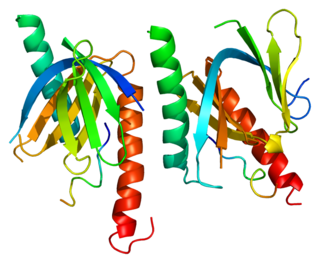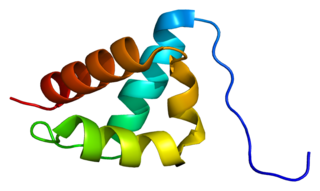
Hsp90 is a chaperone protein that assists other proteins to fold properly, stabilizes proteins against heat stress, and aids in protein degradation. It also stabilizes a number of proteins required for tumor growth, which is why Hsp90 inhibitors are investigated as anti-cancer drugs.

Ovalbumin is the main protein found in egg white, making up approximately 55% of the total protein. Ovalbumin displays sequence and three-dimensional homology to the serpin superfamily, but unlike most serpins it is not a serine protease inhibitor. The function of ovalbumin is unknown, although it is presumed to be a storage protein.

Major sperm protein (MSP) is a nematode specific small protein of 126 amino acids with a molecular weight of 14 kDa. It is the key player in the motility machinery of nematodes that propels the crawling movement/motility of nematode sperm. It is the most abundant protein present in nematode sperm, comprising 15% of the total protein and more than 40% of the soluble protein. MSP is exclusively synthesized in spermatocytes of the nematodes. The MSP has two main functions in the reproduction of the helminthes: i) as cytosolic component it is responsible for the crawling movement of the mature sperm, and ii) once released, it acts as hormone on the female germ cells, where it triggers oocyte maturation and stimulates the oviduct wall to contract to bring the oocytes into position for fertilization. MSP has first been identified in Caenorhabditis elegans.
A turn is an element of secondary structure in proteins where the polypeptide chain reverses its overall direction.
Acidophiles or acidophilic organisms are those that thrive under highly acidic conditions. These organisms can be found in different branches of the tree of life, including Archaea, Bacteria, and Eukarya.

Calmodulin 1 is a protein that in humans is encoded by the CALM1 gene.

14-3-3 protein theta is a protein that in humans is encoded by the YWHAQ gene.

Acyl-CoA-binding protein in humans belongs to the family of Acyl-CoA-binding proteins.

Amyloid beta A4 precursor protein-binding family A member 1 is a protein that in humans is encoded by the APBA1 gene.

Pre-mRNA-processing factor 40 homolog A is a protein that in humans is encoded by the PRPF40A gene.

Tripartite motif-containing 24 (TRIM24) also known as transcriptional intermediary factor 1α (TIF1α) is a protein that, in humans, is encoded by the TRIM24 gene.

cAMP-dependent protein kinase type I-beta regulatory subunit is an enzyme that in humans is encoded by the PRKAR1B gene.

Protein BEX2 also known as brain-expressed X-linked protein 2 is a protein that in humans is encoded by the BEX2 gene.

Protein BEX1 also known as brain-expressed X-linked protein 1 is a protein that in humans is encoded by the BEX1 gene.

In molecular biology, the protein domain surE refers to survival protein E. It was originally found that cells that did not contain this protein, could not survive in the stationary phase, at above normal temperatures, and in high-salt media. Hence the name, survival protein E. It is a metal ion-dependent phosphatase that is found in bacteria, and eukaryotes. It is an important stress response protein. This domain is found in acid phosphatases, 5'-nucleotidases, 3'-nucleotidases and exopolyphosphatases.

In molecular biology, excisionase is a bacteriophage protein encoded by the Xis gene. It is involved in excisive recombination by regulating the assembly of the excisive intasome and by inhibiting viral integration. It adopts an unusual winged-helix structure in which two alpha helices are packed against two extended strands. Also present in the structure is a two-stranded anti-parallel beta-sheet, whose strands are connected by a four-residue wing. During interaction with DNA, helix alpha2 is thought to insert into the major groove, while the wing contacts the adjacent minor groove or phosphodiester backbone. The C-terminal region of excisionase is involved in interaction with phage-encoded integrase (Int), and a putative C-terminal alpha helix may fold upon interaction with Int and/or DNA.

A response regulator is a protein that mediates a cell's response to changes in its environment as part of a two-component regulatory system. Response regulators are coupled to specific histidine kinases which serve as sensors of environmental changes. Response regulators and histidine kinases are two of the most common gene families in bacteria, where two-component signaling systems are very common; they also appear much more rarely in the genomes of some archaea, yeasts, filamentous fungi, and plants. Two-component systems are not found in metazoans.

In molecular biology, the jacalin-like lectin domain is a mannose-binding lectin domain with a beta-prism fold consisting of three 4-stranded beta-sheets, with an internal pseudo 3-fold symmetry. Some lectins in this group stimulate distinct T- and B-cell functions, such as Jacalin, which binds to the T-antigen and acts as an agglutinin. This domain is found in 1 to 6 copies in lectins. The domain is also found in the salt-stress induced protein from rice and an animal prostatic spermine-binding protein.

In molecular biology, the protein domain UBA is short for ubiquitin-associated domains. Ubiquitin is a signal added to an incorrectly folded protein, which allows it to be degraded by the proteasome, and the amino acid constituents can be recycled.















